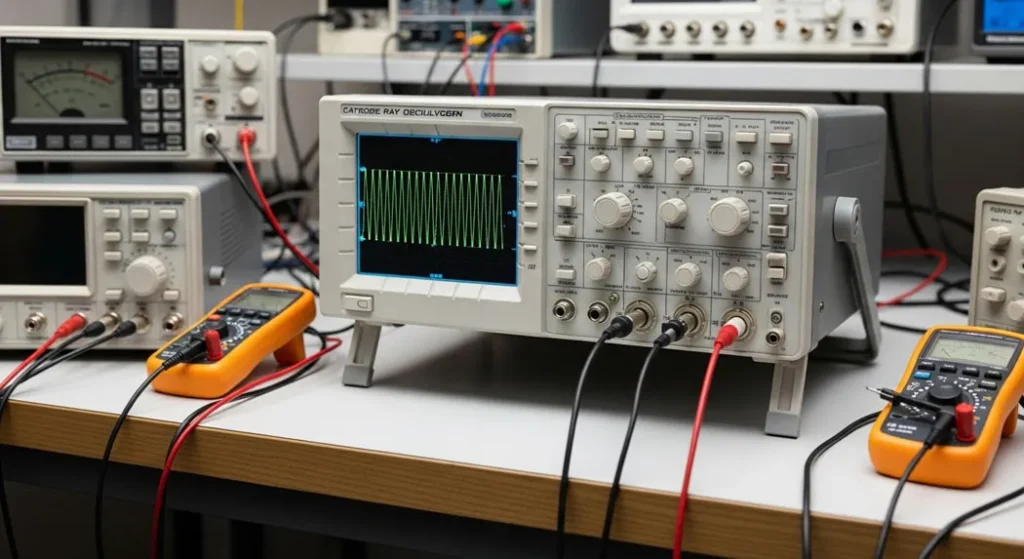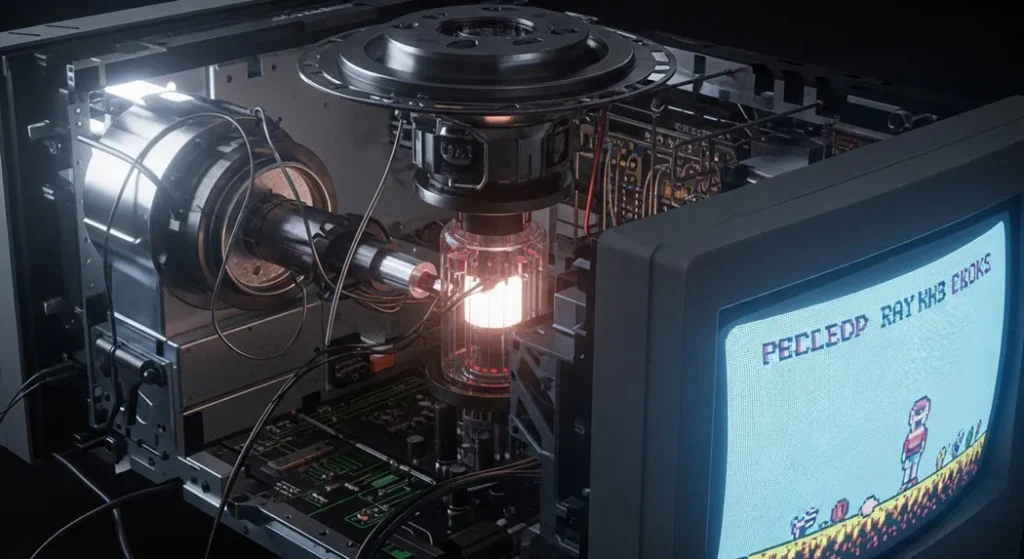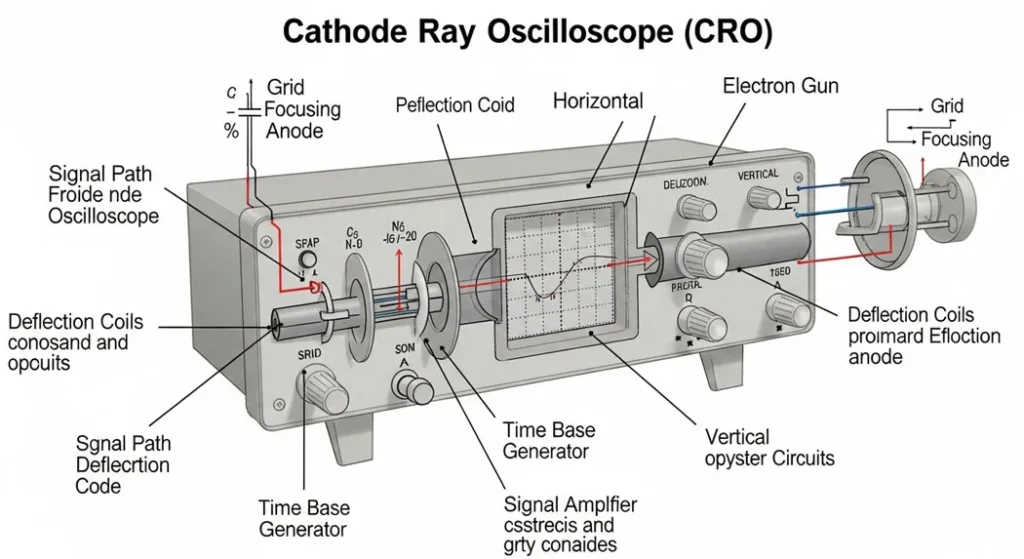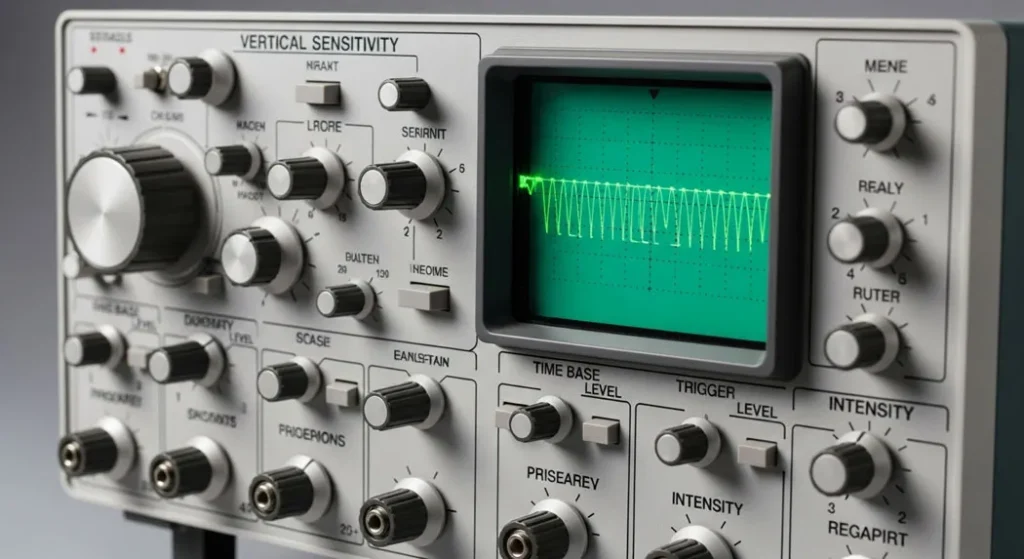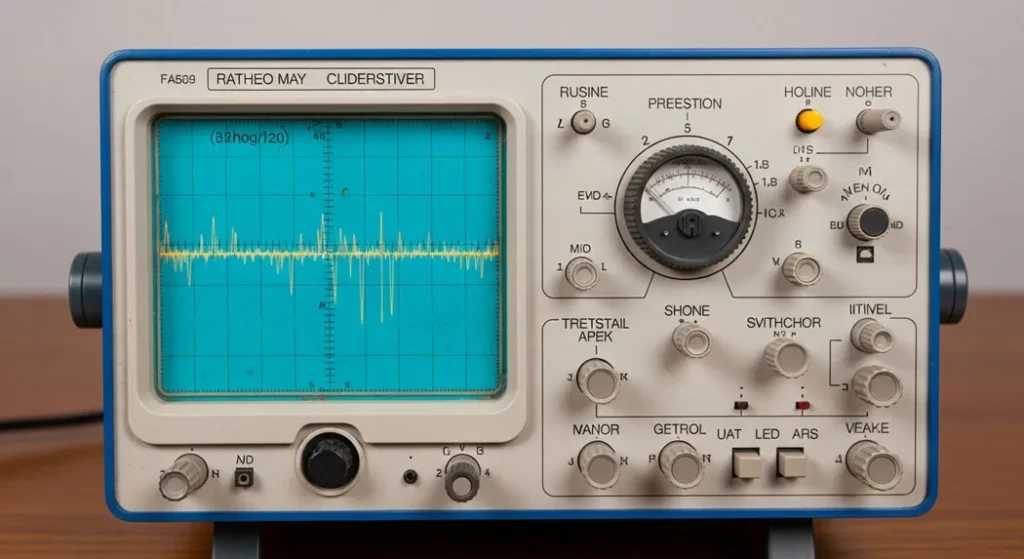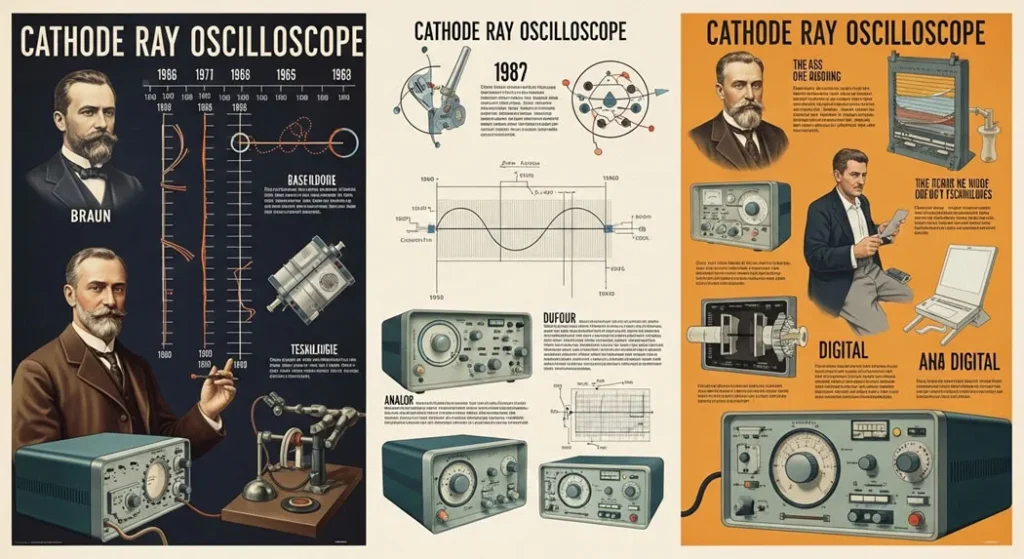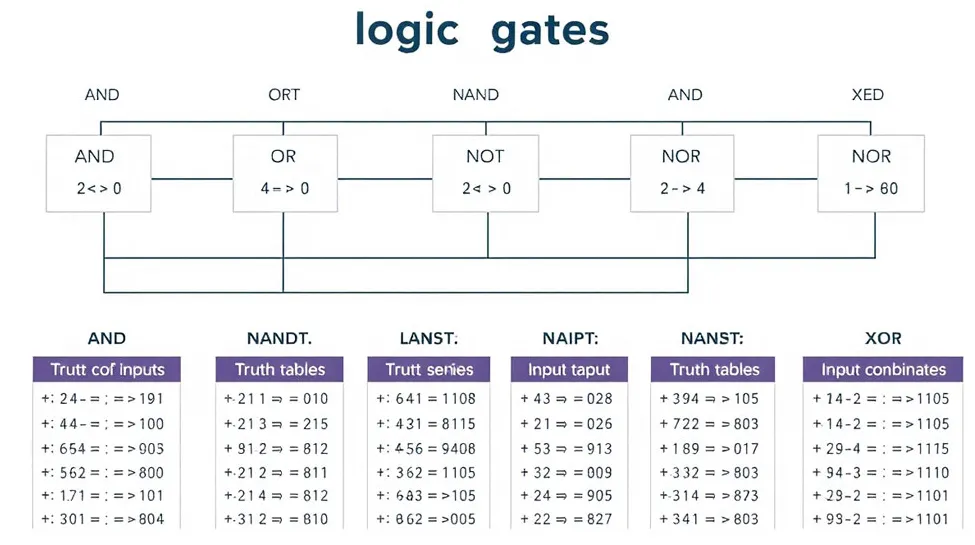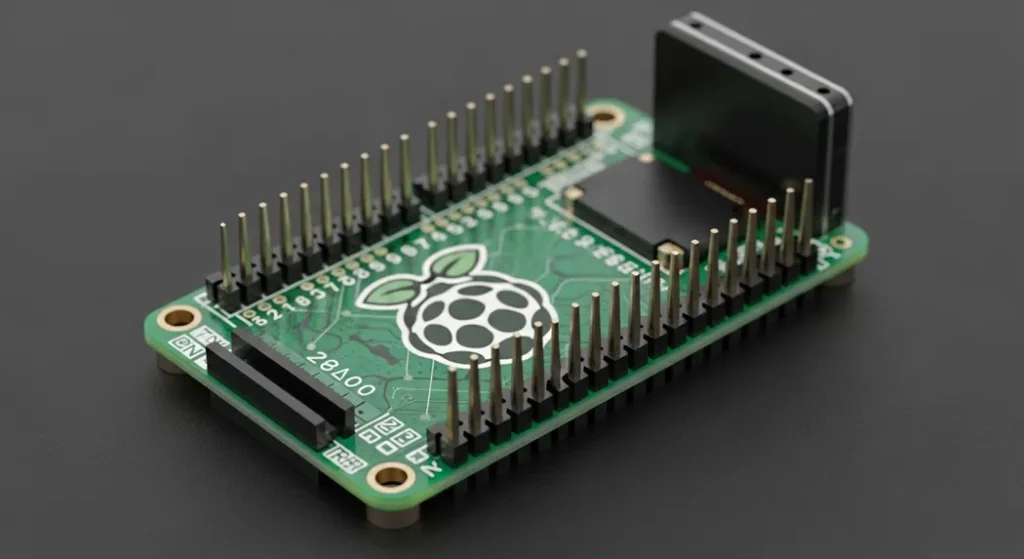What is a Cathode Ray Oscilloscope ?
A cathode ray oscilloscope, or CRO, is a tool that lets you see electrical signals as pictures on a screen. Think of it as a TV for your circuits, showing you how voltage changes over time. In modern contexts, while digital oscilloscopes have largely replaced traditional CROs due to their portability and advanced features like storage and analysis capabilities, the classic CRO remains a fundamental educational tool for understanding analog signal visualization. Whether you’re a student in an electronics lab or a hobbyist fixing a radio, the CRO helps you understand what’s happening inside your circuits by displaying signals as wavy lines called waveforms.
The term “CRO” stands for Cathode Ray Oscilloscope, named after its main component, the cathode ray tube (CRT), which creates the display. In electronics, a CRO is like a microscope for signals it shows you their shape, size, and timing, helping you spot problems or confirm that everything’s working as it should. The technology behind CROs dates back to the late 19th century, with significant developments in the 1930s, making it a cornerstone in fields like telecommunications, medical equipment testing, and audio engineering.
Why Should You Care About CROs?
If you’re into electronics, a CRO is your best friend. It’s used to:
Check how signals behave in circuits, like in radios or amplifiers. For instance, in RF (radio frequency) circuits, you can observe modulation patterns to ensure proper transmission. Find faults, like unwanted noise or distortion. This includes identifying issues such as clipping in amplifiers or interference from electromagnetic sources.
- Measure things like voltage, frequency, or timing. Using built-in scales and cursors, you can precisely calculate peak-to-peak voltage, period, and phase differences between signals.
- Learn about electronics by seeing signals in action. Hands-on experiments, such as viewing sine waves from function generators, help build intuition for concepts like AC vs. DC signals.
How Does a Cathode Ray Oscilloscope Work?

At its core, a CRO takes an electrical signal and turns it into a visible picture. Here’s a simple breakdown of how it works. Inside the CRO, there’s a cathode ray tube (CRT), a vacuum tube that acts like the heart of the device. The CRT has an electron gun that shoots a beam of electrons toward a screen coated with a special material that glows when hit. This creates a bright spot on the screen. The phosphor coating on the screen determines the persistence of the glow, with longer persistence useful for slow signals and shorter for fast transients to avoid blurring.
When you connect a circuit to the CRO using a probe, the signal’s voltage controls how the electron beam moves. The beam moves up and down to show the signal’s strength (voltage) and left to right to show time passing. The result? A wavy line on the screen that represents your signal’s behavior. This vertical deflection is proportional to the input voltage, while horizontal deflection is driven by an internal time-base circuit, enabling time-domain analysis.
Think of it like drawing a graph with a super-fast pencil. The CRO’s “pencil” is the electron beam, and it draws the signal’s ups and downs as time moves forward. To keep the picture steady, a trigger circuit locks the waveform in place, so it doesn’t flicker or jump around. Triggering can be set to edge, pulse width, or video modes in advanced models, ensuring stable displays even for complex or periodic signals.
The Heart of the CRO: The Cathode Ray Tube (CRT)

The cathode ray tube is what makes a CRO special. Let’s break it down:
- Electron Gun: This part creates the electron beam. It’s like a tiny cannon that fires electrons by heating a cathode (a metal piece) and accelerating the electrons with high voltage. The gun includes a control grid to adjust beam intensity (brightness) and a focusing anode to sharpen the spot for clearer traces.
- Deflection Plates: There are two sets of plates one moves the beam up and down (vertical), and the other moves it side to side (horizontal). These plates use electric fields to steer the beam based on the signal. In electrostatic deflection CROs, which are common, the plates respond quickly to high-frequency signals, unlike magnetic deflection used in some TVs.
- Fluorescent Screen: This is the glowing screen where the electron beam hits, creating a visible trace of the signal. It’s coated with a material that lights up when electrons strike it. Common phosphors include P31 (green) for general use or P4 (white) for photography, with screen graticules aiding precise measurements.
The CRT is why CROs are called “cathode ray” oscilloscopes it’s all about that electron beam creating a picture of your signal. Although CRT-based CROs are less common today due to LCD/LED digital scopes, they offer unique advantages like infinite resolution in analog displays.
Key Parts of a CRO: What’s inside?

To understand a CRO, you need to know its main components. Here’s a simple look at what makes it tick:
- Probes: These are the cables you connect to your circuit to capture the signal. They’re like the CRO’s hands, reaching out to grab the data. Probes often have a switch to adjust their sensitivity (like 1x or 10x). Passive probes are standard, but active probes with built-in amplifiers are used for high-impedance or high-frequency applications to minimize loading effects on the circuit.
- Vertical Amplifier: This boosts the signal’s voltage so it’s big enough to see on the screen. It’s like turning up the volume on your signal. It includes attenuation controls (volts/div) to scale the display and position knobs to center the trace, with bandwidth limits to filter noise.
- Time Base Generator: This controls how fast the beam moves across the screen horizontally, showing time. It creates a steady sweep so you can see how the signal changes over time. It generates a linear ramp voltage (sawtooth wave) to sweep the beam evenly, with variable time/div settings from microseconds to seconds for observing fast transients or slow events. Additional features like delayed sweep allow zooming into specific parts of the waveform for detailed analysis.
- Trigger Circuit: This keeps the waveform steady by starting the sweep at the same point in the signal each time. Without it, the waveform would dance around the screen.
- Horizontal Amplifier: This works with the time base to move the beam side to side.
- Power Supply: Provides the high and low voltages needed for the CRT and other parts to work.
A Peek at the CRO’s Front Panel

When you look at a CRO, you’ll see a front panel full of knobs and buttons. Don’t be intimidated! Here’s what the main controls do:
- Power Switch: Turns the CRO on or off.
- Brightness and Focus: Adjust the clarity and brightness of the beam on the screen.
- Voltage/Division (Volts/Div): Sets how much voltage each vertical grid square represents. For example, if set to 1V/div, each square shows 1 volt.
- Time/Division (Time/Div): Sets how much time each horizontal grid square represents. For example, 1ms/div means each square is 1 millisecond.
- Position Controls: Move the waveform up, down, left, or right on the screen.
- Trigger Controls: Adjust how the CRO locks onto the signal to keep the display steady.
- Channel Select: Chooses which input (Channel 1 or 2) to display, or both for comparing two signals.
These controls let you zoom in, shift, and stabilize the waveform to get a clear view of your signal.
How to Use a Cathode Ray Oscilloscope: A Beginner’s Tutorial

Ready to try a CRO? Here’s a step-by-step guide to get you started:
- Set Up the CRO:
- Plug it in and turn it on. Give it a minute to warm up (older models need this).
- Adjust the brightness and focus until you see a clear dot or line on the screen.
- Connect the Probe:
- Plug a probe into Channel 1’s input jack.
- Connect the probe’s tip to your circuit’s test point and the ground clip to the circuit’s ground. This grabs the signal you want to see.
- Adjust the Display:
- Use the Volts/Div knob to make the waveform’s height fit the screen. If it’s too tall or flat, tweak this setting.
- Use the Time/Div knob to spread the waveform across the screen. If it’s too squished or stretched, adjust this.
- Stabilize the Waveform:
- Set the trigger source to Channel 1 and adjust the trigger level until the waveform stops jittering. This locks it in place for easy viewing.
- Measure the Signal:
- Count the vertical grid squares to find the signal’s amplitude (peak-to-peak voltage). Multiply by the Volts/Div setting.
- Count the horizontal squares for one cycle to find the period (time for one wave). Multiply by the Time/Div setting, then calculate frequency using f = 1/T.
For example, if a waveform is 4 squares tall at 2V/div, the amplitude is 4 × 2 = 8 volts. If one cycle spans 5 squares at 1ms/div, the period is 5 × 0.001 = 0.005 seconds, so the frequency is 1/0.005 = 200 Hz.
Tip: Start with a simple signal, like a 1 kHz sine wave from a function generator, to practice. It’s like learning to ride a bike with training wheels!
What Can a CRO Measure?
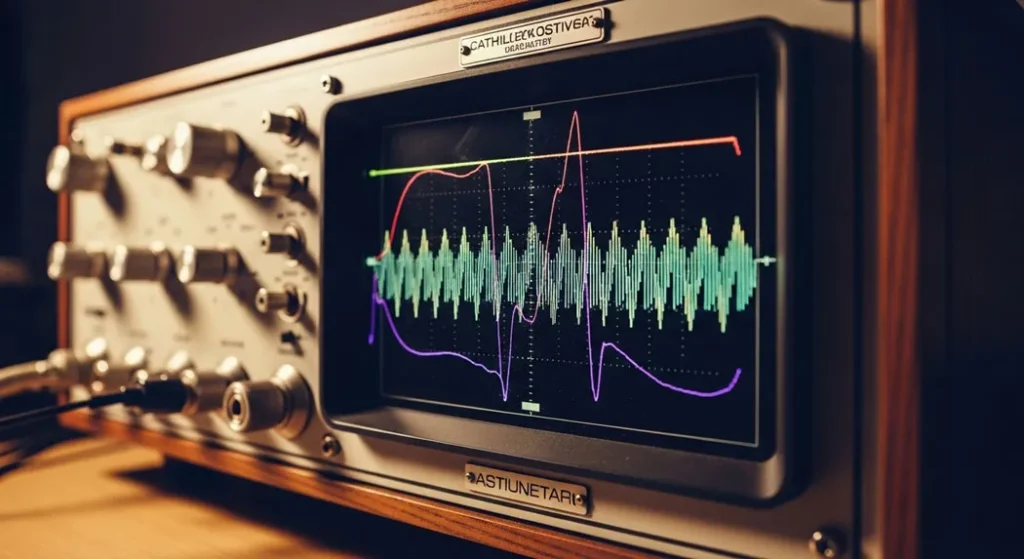
A CRO is like a Swiss Army knife for electronics. Here’s what it can do:
- Voltage: Measure the height of the waveform to find peak or peak-to-peak voltage.
- Frequency: Count the time for one cycle to calculate how often the signal repeats.
- Phase Difference: Compare two signals on dual channels to see if they’re in sync.
- Waveform Shape: Check if the signal is a clean sine wave, a square wave, or distorted.
- Noise and Glitches: Spot unwanted spikes or wiggles in the signal.
For instance, if you’re testing a power supply, a CRO can show if the output is a steady DC line or if it has ripples that need fixing.
Applications of a Cathode Ray Oscilloscope
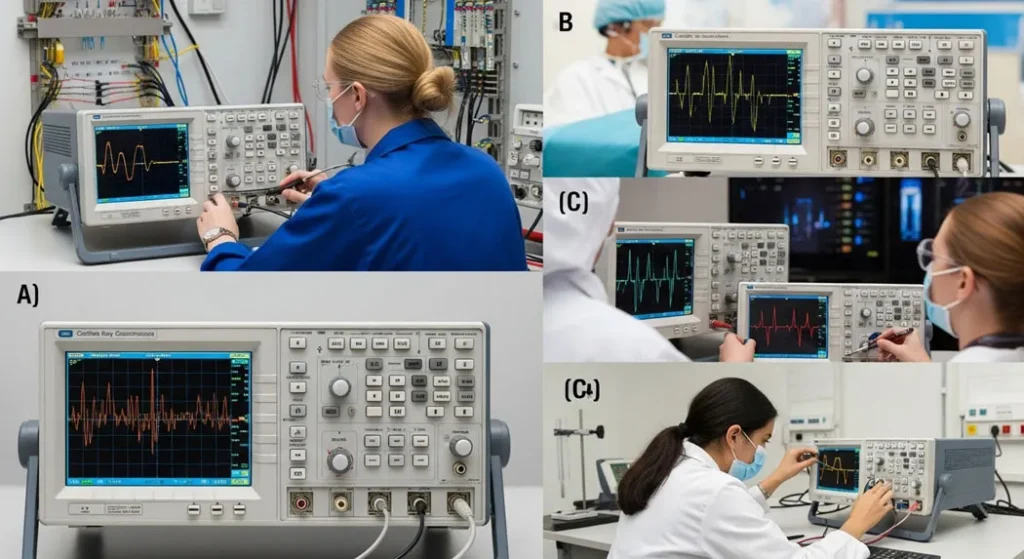
CROs are used in all sorts of fields. Here are some examples:
- Electronics Labs: Students use CROs to study signals in circuits, like amplifiers or oscillators.
- Circuit Debugging: Engineers check for faults in devices like radios or TVs.
- Audio Engineering: Analyze audio signals to ensure clear sound without distortion.
- Medical Equipment: Monitor signals in devices like ECG machines to check heart activity.
- Telecommunications: Test signal quality in phone or internet systems.
For example, if you’re fixing a guitar amplifier, a CRO can show if the signal is clipping, helping you adjust the circuit for better sound.
CRO vs. Digital Oscilloscope: What’s the Difference?
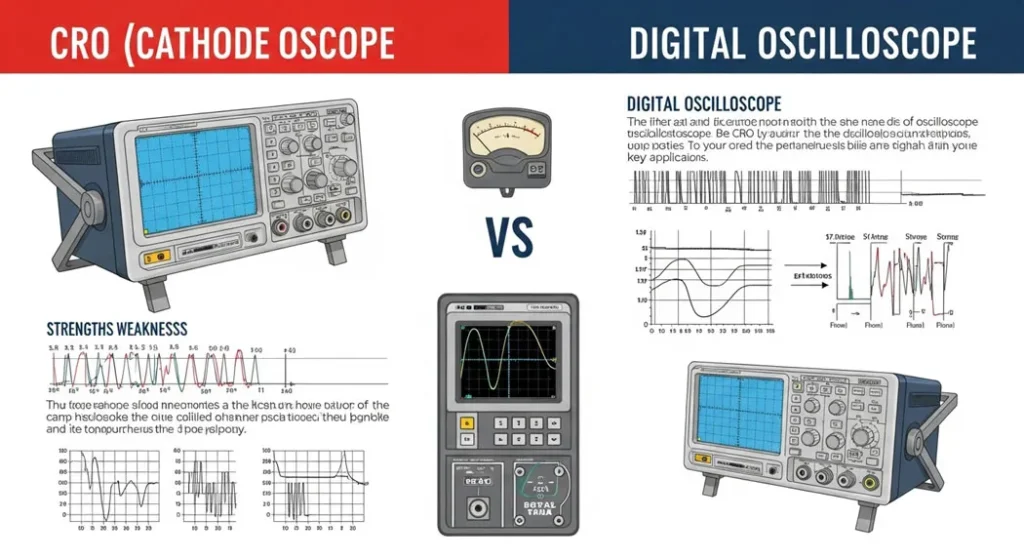
Today, you might hear about digital storage oscilloscopes (DSOs) alongside CROs. Here’s how they compare:
- CRO (Analog): Uses a CRT to display signals in real-time. It’s simple, affordable, and great for basic tasks but can’t store waveforms.
- DSO (Digital): Converts signals to digital data, offering storage, advanced analysis, and more features. They’re pricier but more versatile.
For beginners, a CRO is a great starting point because it’s straightforward and often cheaper, especially if you find a used one. Think of a CRO as a classic car reliable and fun to learn on, even if it doesn’t have the bells and whistles of a modern DSO.
Tips for Using a CRO Like a Pro
Here are some beginner-friendly tips to make your CRO experience smooth:
- Start with a Known Signal: Use a function generator to create a simple sine wave to practice adjusting controls.
- Check Your Probes: Make sure they’re set to the right attenuation (1x or 10x) to avoid misreading voltages.
- Calibrate First: Most CROs have a built-in test signal. Use it to check that your settings are correct.
- Avoid Overloading: Don’t feed the CRO a signal stronger than its maximum input voltage (check the manual).
- Practice Reading Waveforms: Spend time with different signals (sine, square, triangle) to get comfortable spotting their shapes.
The History of CROs: A Quick Look

The CRO has a cool backstory. It started in the late 1890s when Karl Ferdinand Braun invented the cathode ray tube, earning a Nobel Prize. By the 1930s, CROs became practical tools for engineers, thanks to improvements in vacuum tubes. They were game-changers, letting people see signals for the first time. While digital oscilloscopes are more common now, CROs are still loved in labs for their simplicity and hands-on feel.
Common Questions About CROs
Let’s answer some questions you might have:
- What’s the full form of CRO? It stands for Cathode Ray Oscilloscope.
- What’s a CRT in engineering? It’s the Cathode Ray Tube, the display component that shows waveforms.
- What’s the purpose of synchronizing control in a CRO? It stabilizes the waveform by syncing the sweep with the signal.
- Can a CRO measure DC signals? Yes, it shows DC as a flat line at the signal’s voltage level.
- What’s the difference between a CRO and an oscillograph? An oscillograph records signals on paper, while a CRO shows them on a screen in real-time.
Getting Started with Your Own CRO
If you’re ready to try a CRO, here’s how to begin:
- Find a CRO: Look for used models online or at electronics surplus stores. Prices range from $100 to $500 for basic units.
- Set Up a Simple Circuit: Try a battery and resistor circuit or a function generator to create signals.
- Experiment: Play with the controls to see how they affect the waveform. It’s like learning to play an instrument practice makes perfect.
Fun Experiment: Connect a CRO to a microphone circuit and speak into it. Watch the waveform change with your voice it’s a great way to see the CRO in action!
Conclusion
A cathode ray oscilloscope might seem complex at first, but it’s really just a tool to help you see and understand electrical signals. From its electron-shooting CRT to its user-friendly controls, the CRO is a window into the world of electronics. Whether you’re measuring voltages, debugging circuits, or just exploring, this guide has given you the basics to start using a CRO with confidence. So, grab a probe, fire up your oscilloscope, and start discovering the hidden rhythms of your circuits! Try setting up a CRO with a simple circuit and share your results in the comments. Want more? Check out our other electronics tutorials or download our free CRO setup checklist!


